
Fencing seems to involve poking people with swords. Is it really safe?
Yes. We take safety very seriously. While the sport originated from honor duels to the death, we have moved very far away from that. Our weapons are not sharp, and the tips are designed to register a score on a machine, not to puncture an opponent. All fencers must wear a fencing mask designed to protect the head and face from injury. Women fencers wear a plastic chest protector beneath their fencing jacket. The jackets themselves are designed to withstand punctures.
Fencing. That’s that thing you see in Zorro, right?
Not really. That is stage combat. Every move is carefully choreographed and rehearsed. It looks wonderful on the screen, but it isn’t how people fought in the past, and it isn’t how fencing works now. Though there are days we wish we had a chandelier to swing from, just because it would be cool.
How do I wash my mask and jacket?
Masks
Before putting them in the dishwasher, you might want to carefully use a toothbrush and small amounts of laundry detergent on the tough stains. Place them in your dishwasher with a limited amount of laundry detergent. Do not leave them in for the drying cycle. Remove and let them air dry. You can also tie your mask up in a towel and run it through your dryer. (The towel is to protect your dryer from the banging.)
Jackets
For your jackets, the secret to really getting them clean is to soak them in OxiClean and baking soda for a few hours first. Then run them through the washer in warm water. Don’t wash them on the hottest setting; you don’t want to shrink them.
Lames
Lames are silver or gray vests (for foil) or long-sleeved jackets (for saber). They need to be cleaned very carefully. You can wash them in the bathtub with dish soap. Gently swish them around and soak them in the tub. Then hang them up and thoroughly rinse the soap out. Hang to dry.
I have a question but you don’t have it here.
Contact us with your questions! We will do our best to answer the question or find someone who can. Questions asked may end up on the FAQ later.
I hear a lot of funny terms at the fencing club. What do they all mean?
 Advance
Advance
Taking a step toward one’s opponent.
Attack
Movement or series of movements by which a fencer tries to score a point. In foil and saber, the fencer who attacks first acquires the “right-of-way.” In order to execute a attack properly (i.e., one that the referee will acknowledge), the fencer’s hand must be clearly extending towards their opponent’s valid target in a threatening manner.
Beat
Sharp tap on the opponent’s blade to initiate an attack or provoke a reaction.
Disengage
Evasive action in which the fencer avoids the opponent’s attempt to take their blade.
Engagement
Contact between the fencers’ blades—often as the prelude to an attack.
En Garde
Position taken before fencing commences.
Feint
Explosive, running attack (foil and epee only).
Flunge
Action unique to saber—a combination of a lunge and a fleche. Evolved recently after the FIE modified saber rules in 1992 to prohibit running attacks.
Guard
Part of the weapon between the blade and handle; protects the hand (also: “bell-guard”).
Parry, Counter-Parry
Defensive action in which a fencer blocks his opponent’s blade.
Lunge
Most common attacking technique, in which the fencer launches themselves at their opponent by pushing off from their back leg (which generally remains stationary).
Opposition
“Thrust with Opposition”—To simultaneously deflect the opponent’s point with one’s guard while making an attack of one’s own. Commonly used in epee to avoid a double touch.
Piste
French term for the fencing strip.
Point-in-Line
Action in which the fencer, who is generally out of attacking range, points their weapon at their opponent with their arm fully extended. A fencer who establishes a point in line has right of way, and their opponent cannot attack until they remove the blade from line by executing a beat.
Recover
The return to the en guarde position after lunging.
Remise
Attacking again immediately after the opponent’s parry of an initial attack.
Riposte
Defender’s offensive action immediately after parrying their opponent’s attack.
Second Intention
A tactic in which a fencer executes a convincing, yet false, action in hopes of drawing a true, committed reaction from their opponent.
Stop Hit, Stop Cut (saber)
A counter-action made at the moment of an opponent’s hesitation, feint, or poorly executed attack. To be awarded the point, the fencer attempting a stop hit must clearly catch their opponent’s tempo. Hence, if their Stop Hit is not “in time,” the referee may award the touch to their attacker.
Strip
Fencing area, 14 meters long by 2 meters wide.
Written by: United States Fencing Association
I’d like to have my own gear. Any suggestions?
 Most fencers consider their first fencing gear to be the sweat clothes and athletic shoes that they dress in for their initial lesson. Some of this equipment is borrowed from the club, and some is purchased by the fencer. The USFA requires that all fencers participating in tournaments wear regulation garments: masks, gloves, jackets, chest plates, plastrons, and knickers. While most clubs require students to provide their own gear, in the interest of making fencing affordable for all students, Lincoln Fencing Club provides jackets, masks, chest plates, plastrons, and weapons for students. Gloves are also available, although most students purchase their own. Knickers are not required to participate in classes at LFC; however, there are some available for students’ use.
Most fencers consider their first fencing gear to be the sweat clothes and athletic shoes that they dress in for their initial lesson. Some of this equipment is borrowed from the club, and some is purchased by the fencer. The USFA requires that all fencers participating in tournaments wear regulation garments: masks, gloves, jackets, chest plates, plastrons, and knickers. While most clubs require students to provide their own gear, in the interest of making fencing affordable for all students, Lincoln Fencing Club provides jackets, masks, chest plates, plastrons, and weapons for students. Gloves are also available, although most students purchase their own. Knickers are not required to participate in classes at LFC; however, there are some available for students’ use.
Although injuries are uncommon in fencing—due in part to protective gear required by the sport—they do occasionally happen. If a student is not using knickers, LFC requires that durable long pants should be worn to all classes and lessons. Athletic wear like sweatpants and lined nylon warm-up pants are recommended; jeans or denim pants are discouraged because they do not allow freedom of movement. Socks must be worn, preferably athletic socks. Court-style athletic shoes are preferred. No slip-on shoes, sandals, or open-toed shoes are allowed. If a student is not wearing proper footwear, long pants, or socks and is injured during practice, class, or a lesson, LFC cannot be held responsible. Please make sure to wear appropriate clothing to class, practice, and lessons to minimize the chance of injury.
A natural question, then, is what to purchase when starting to build your personal cache. LFC offers the following advice in response to this inquiry:
- After about 6 months of fencing, most athletes begin their collection of gear with a glove and mask. Obtaining these items provides you with foundational pieces of safety, while offering the privilege of enjoying only your own sweat. Further, you can be assured that what you own will fit you. You must specify whether you are right or left handed when ordering the glove, and decide which size fits you best. The mask size must also be specified. Trying on these pieces at club to determine your size is suggested. Also note that the foil and epee masks are so similar that most people buy the two-weapon mask. Sabre, by definition, is a mask of a different style and should be purchased only if you are specializing in this weapon.
- Once the wallet has been replenished, many fencers choose an electric weapon and one or two body cords as the next purchase. You must again specify right or left handed and the size/style of the grip. The size of the blade varies by age category so you may want to confer with your coach as to the advisable length/size. Most of LFC uses 2-prong body cords, so you will find it more convenient to buy weapons and body cords of this type. It provides more flexibility should you need to borrow equipment.
- Next, a good pair of knickers, jacket, and plastron are desirable. Women additionally buy a chest protector at this stage. As with all of the equipment, FIE is necessary only if you are going to fence in international events. Many fencers start with a set that is less expensive than FIE. If you are going to a tournament where vendors will be displaying goods, you may want to try on the different styles and sizes of uniforms. You can purchase during the event, or just use it as a research opportunity and order off the web. It is a requirement to wear your last name on the knickers or the lame’/jacket. Some people use home-made methods to accomplish this and others pay vendors to do so. Either way, many prefer the name on the knickers. This eliminates the need to label multiple jacket/lame’ combinations for various weapons. The knickers last longer than do lame’s, so it is a bit more economical as well.
- Finally, the lame’ completes the basics. A well-fit lame’, in good shape, helps to assure integrity in a foil or sabre bout. The foil lame’ is typically purchased first. Like the sabre mask, the sabre lame’ is typically an early purchase only if you are specializing in this weapon. Those specializing in sabre will often purchase the mask cord and gauntlet simultaneously with the lame’.
- Assorted other items can be purchased after the basics. Some prefer to buy actual fencing shoes vs. general athletic shoes. The key to a good shoe for fencing is one that is not too bulky in the sole but provides ample cushioning in the heel. It should provide good support to the whole foot. Some people enjoy court or running shoes and others prefer wrestling styles.
Note: There are currently 20 major vendors of fencing equipment. You can access these at http://www.usfencing.org/ under Info for Members, Equipment Vendors.
No matter whether your equipment is from your own private gear or is provided by the club, you will want to be sure to have it well organized for practice and tournaments. Be sure to put your name on all personal equipment, and use the packing list when preparing for tournaments. Click Here for LFC Packing List. Once you’ve arrived, you will be glad that you geared up!

Jacket, mask, and glove.
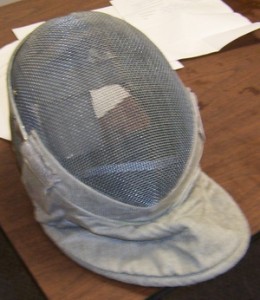
A sabre mask. It is silvery, to register scoring electronically, as the head is a target in sabre.
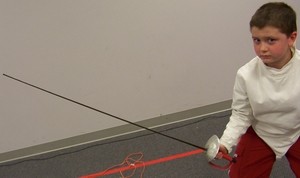
A sabre being held.
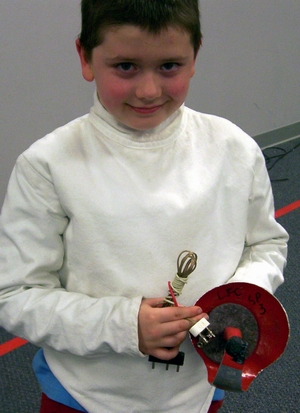
A sabre’s grip and body cord. The sabre grip is designed to protect the hand from the slashing attacks of sabre.
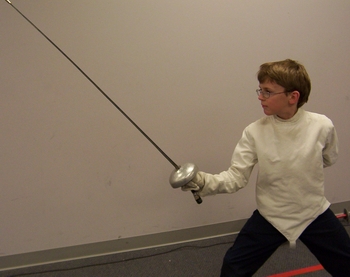
An epee being held.
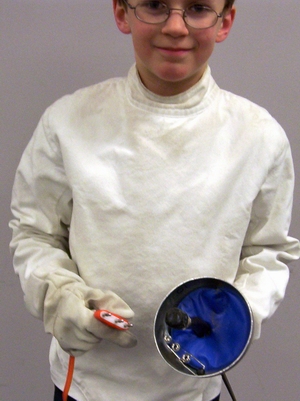
An epee grip and body cord. The epee’s larger guard, called a bell, is to protect the hand, which is a target in epee.
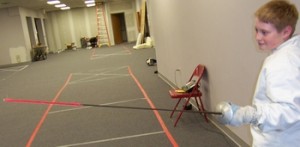
A foil being held.
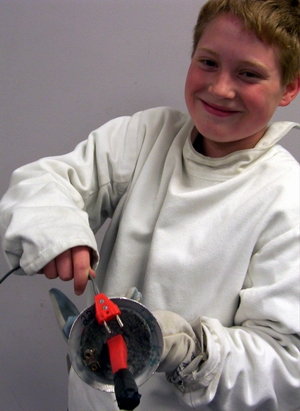
A foil grip and body cord. The foil guard is smaller, as the hand is not a target in foil.
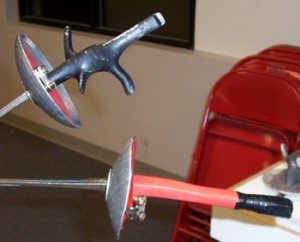
Two foil grips. Above is the pistol grip, a more ergonomic handle that many prefer. Below is the traditional French grip.
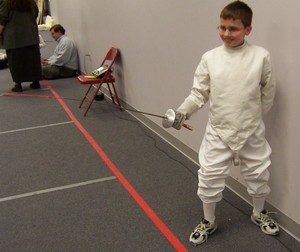
A full fencing outfit, without mask. Jacket, glove, knickers, socks covering the shins, and athletic shoes.
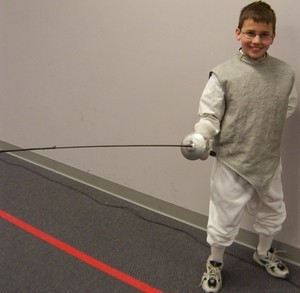
A full fencing outfit, without mask, and with a lame for foil fencing. The silvery material helps register touches electronically. The lame covers all parts considered targets in foil fencing.
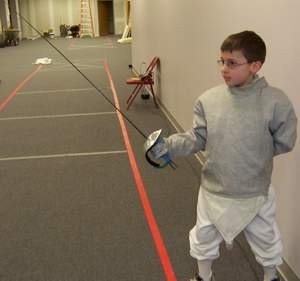
A full sabre outfit, without mask. The silvery material helps register touches electronically. The lame covers all parts considered targets in sabre fencing, including arms. The sabre mask is also covered with this material, as the head is also a target.
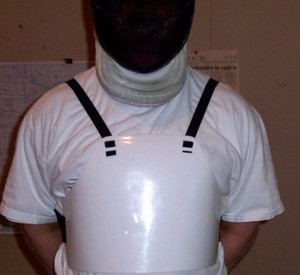
Men’s chest protector. While not required, many fencers wear them for extra protection.
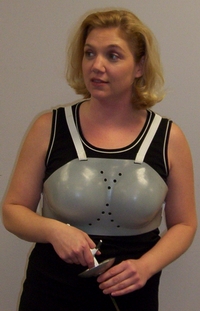
Women’s breast protector. The plastic protection is required for all female fencers.
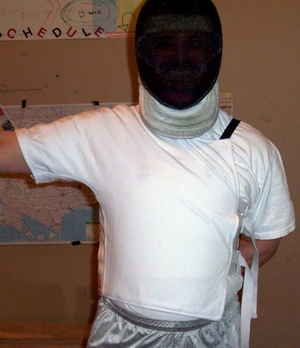
A plastron. This extra protection covers the side of the body of the fencer’s weapon hand. Required in some tournaments, many fencers wear them even when not required, for extra safety.
I’m heading to a tournament. What should I bring?
Mark all items with your name and all valuables with address, phone #, & club
Basic:
Mask (sewn-in bib, must pass 12 K punch test)
Mask Cord (for sabre only)
Underarm Protector (plastron)
Breast Protector (mandatory for women)
Jacket (no holes, must close in back or opposite weapon arm)
Lame’
Knickers (no holes, must be overlapped by jacket by at least 4 inches)
Glove (no holes except for body cord, must cover approximately half forearm)
Gauntlet (for sabre only)
Long Socks (traditionally white, must reach bottom of your knickers)
Fencing Shoes or Sneakers
Minimum 2 working weapons
Minimum 2 working body cords
Fencing Bag
Water Bottle / Athletic Drink
Healthy Snacks
Tournament Flyer / Driving Directions / Evidence of Pre-registration
USFA Card
Adequate cash, check, credit card, etc.
Medical Insurance Card / Emergency Contacts
Advisable:
Notebook
Sweat Towel and old towel for cleaning shoes
Team Jacket or Sweat Jacket
Dry shirt / change of clothes
Under-knicker shorts
Athletic supporter / cup (Men only)
Sports bra (Women only)
Tool Kit, Needle and Thread, Test Box
Tissues, Band-Aids, pain killers, Tums, etc.
Hair Ties / Comb / Brush
Optional:
USFA Rule Book
Strip set-up (reels / box) as Promised to Host Club
Shower Items: towel, shampoo, soap, and plastic bag to hold wet equipment
Camera / Film
Cell Phone / Phone Card
Folding Chair
Spectators / Spectator Hobbies To Pass Time
Homework, Book, Hacky-Sack / Lucky Rabbit’s Foot / CD Player / Gameboy
Overnight:
Toothbrush / sundries / cosmetics
Medication
Pajamas
Swim Suit
Change of Clothes
Sleeping bag / pillow
Hotel / Host Directions
by: Lisa Franz
I’m interested but want to take a look first. Is this possible?
Yes! You can stop by any time during open fencing. Mondays and Wednesdays at 7:30 p.m. are probably best, as one of our coaches is usually available. We’ll answer questions, and if you are interested, we’ll suit you up and let you try it!
Is there fencing in Omaha?
Yes. You can check out their website, http://www.omahafencingclub.org/.
It’s snowing outside. Do we fence?
The rule of thumb is if Lincoln Public Schools are closed due to inclement weather, then Lincoln Fencing Club will also be closed.
So, how much does this cost?
Costs vary based on the type of membership you’re interested in getting. Please refer to the Fees page for further information. There are also discounts for additional family members . LFC’s fees are more than reasonable compared to most health clubs.
So, what is fencing?
Fencing is a sport. Born in the days of blood combat, it is now a sport with rules, scoring methods, and special equipment.
The sport of fencing is fast and athletic, a far cry from the choreographed bouts you see on film or on the stage. Instead of swinging from a chandelier or leaping from balconies, you will see two fencers performing an intense dance on a 6-feet by 44-feet strip. The movement is so fast the touches are scored electrically—a lot more like Star Wars than Errol Flynn.
The Bout
Competitors win a fencing bout (what an individual “game” is called) by being the first to score 15 points (in direct elimination play) or 5 points (in preliminary pool play) against their opponent, or by having a higher score than their opponent when the time limit expires. Each time a fencer lands a valid hit—a touch—on their opponent, they receive one point. The time limit for direct elimination matches is nine minutes—three three-minute periods with a one-minute break between each.
Fencers are penalized for crossing the lateral boundaries of the strip, while retreating off the rear limit of their side results in a touch awarded to their opponent.
Team matches feature three fencers squaring off against another team of three in a “relay” format. Each team member fences every member of the opposing team in sequence over 9 rounds until one team reaches 45 touches or has the higher score when time expires in the final round.
Fencing at the Olympic Games will feature a single-elimination table format, much like that used in Tennis. There will be no preliminary rounds, as the initial seeding into the table will be determined by World Rankings.
The Weapons
Foil, epee, and saber are the three weapons used in the sport of fencing. While some fencers compete in all three events, elite generally choose to focus their energies on mastering one weapon.
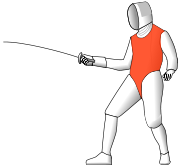
Foil – The Sport of Kings
The foil is a descendant of the light court sword formerly used by nobility to train for duels. It has a flexible, rectangular blade approximately 35 inches in length and weighing less than one pound. Points are scored with the tip of the blade and must land on valid target: torso from shoulders to groin in the front and to the waist in the back. The arms, neck, head and legs are considered off-target – hits to this non-valid target temporarily halts the fencing action, but does not result any points being awarded. This concept of on-target and off-target evolved from the theory of 18th-century fencing masters, who instructed their pupils to only attack the vital areas of the body (i.e., the torso). Of course, the head is also a vital area of the body, but attacks to the face were considered unsporting and therefore discouraged.
Although top foil fencers still employ classical technique of parries and thrusts, the flexible nature of the foil blade permits the modern elite foil fencer to attack an opponent from seemingly impossible angles.
Competitors often “march” down the fencing strip at their opponent, looking to whip or flick the point of their blade at the flank or back of their opponent. Because parrying (blocking) these attacks can be very difficult, the modern game of foil has evolved into a complicated and exciting game of multiple feints, ducking and sudden, explosive attacks.
Rules: Understanding “Right-of-Way”
For newcomers to foil fencing, one of the challenging concepts to grasp is the rule of right-of-way. Right of Way is a theory of armed combat that determines who receives a point when the fencers have both landed hits during the same action. The most basic, and important, precept of right of way is that the fencer who started to attack first will receive the point if they hit valid target. Naturally, fencer who is being attacked must defend themselves with a parry, or somehow cause their opponent to miss in order to take over right of way and score a point. Furthermore, a fencer who hesitates for too long while advancing on their opponent gives up right-of-way to their opponent. A touch scored against an opponent who hesitated too long is called an attack in preparation or a stop-hit, depending on the circumstances.
Additionally, the referee may determine that the two fencers truly attacked each other simultaneously. This simultaneous attack is a kind of tie—no points are awarded, and the fencers are ordered back en garde by the referee to continue fencing
While it may be difficult to follow the referee’s calls (not helped by the fact that the officiating is performed in French!), the referee always clearly raises their hand on the side of the fencer for whom they have awarded a point. Watching for these hand signals can make it easier for newcomers to follow the momentum of a fencing bout without understanding all the intricacies of the rules.
Equipment
Because foil actions often occur at blinding speed, an electrical scoring system was devised to detect hits on valid target. Each foil has a blunt, spring-loaded button at the point of the blade that must be depressed with a pressure of 500 grams or better to register a hit. The foil fencer’s uniform features an electrically wired metallic vest called a lamé—a hit to the lamé causes the scoring machine to display a colored light on the side of the fencer that scored the touch. Meanwhile, a hit off target—on the arms, legs or head, which are not covered by the lamés—causes the machine to display a white light. As mentioned earlier, hits off target stop the action of the match temporarily, but do not result in a touch being awarded. If the scoring machine displays both a colored light and a white light, it means the fencer quickly hit off target and then hit on target before the machine could lock out. In such situations, the fencer’s hit is ruled off target and no touch is awarded.
Another part of the fencer’s equipment is a special cable called a body cord. This plugs into his foil and runs though the sleeve of his arm out the back of his uniform, connecting to a retractable reel which is, in turn, connected to the scoring machine. Of course, with all this equipment a lot can go wrong, so before each foil bout commences, both fencers ceremoniously test each other’s lamés to ensure they are working properly.
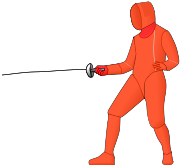
Epee – Freestyle Fencing
The epee (pronounced “EPP-pay”—literally meaning “sword” in French) is the descendant of the dueling sword, but is heavier, weighing approximately 27 ounces, with a stiffer, thicker blade and a larger guard. As in foil, touches are scored only with the point of the blade, however in epee the entire body, head-to-toe, is valid target—much like in an actual duel.
Similar to the foil, the point of the epee is fixed with a blunt, spring-loaded button. However, the epee tip requires more than 750 grams of pressure to register a touch with the scoring machine (basically, epee fencers have to hit harder). Because the entire body is a valid target area, epee fencers do not have to wear a metallic lamé. There is no concept of “off-target” in epee—anything goes.
Rules
Unlike foil, epee does not employ a system of “right-of-way.” Fencers score a point by hitting their opponent first. If the fencers hit each other within 1/25th of a second, both receive a point; this is commonly referred to as a double touch. The lack of right-of-way combined with a full-body target naturally makes epee a game of careful strategy and patience—wild, rash attacks are quickly punished with solid counter-attacks. So, rather than attacking outright, epeeists often spend several minutes probing their opponent’s defenses and maneuvering for distance before risking an attack. Others choose to stay on the defensive throughout the entire bout.
1996 was the first Olympics to feature team and individual Women’s Epee events.
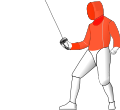
Saber – Hack and Slash
The saber is the modern version of the slashing cavalry sword. As such, the major difference between saber and the other two weapons is that saberists can score with the edge of their blade as well as their point. In saber, the target area is the entire body above the waist, excluding the hands. The lower half is not valid target, which is meant to simulate a cavalry rider on a horse. In addition, saber employs rules of right of way which are very similar to foil but with subtle differences. Like foil, the fencer who starts to attack first is given priority should his opponent counter-attack. However, saber referees are much less forgiving of hesitation by an attacker. It is common to see a saber fencer execute a stop cut against their opponent’s forearm during such a moment of hesitation, winning right of way an the point.
Again, as in foil, the saber fencer’s uniform features an electrically wired metallic lamé, which fully covers their valid target area. Because the head is valid target area, the fencer’s mask is also electrically wired. One significant departure from foil is that off-target hits do not register on the scoring machine, and therefore do not halt the fencing action. Saber fencing is also the first of the three weapons to feature a wireless scoring system.
If epee is the weapon of patient, defensive strategy, then saber is its polar opposite. In saber, the rules of right of way strongly favor the fencer who attacks first, and a mere graze by the blade against the lamé registers a touch with the scoring machine. These circumstances naturally make saber a fast, agressive game, with fencers rushing their opponent from the moment their referee gives the instruction to fence. In fact, a lopsided saber match can literally be over in seconds. As fending off the attack of a skilled opponent is nearly impossible, saber fencers very rarely purposely take the defensive. However, when forced to do so, they often go all-out using spectacular tactical combinations in which victory or defeat is determined by a hair’s breadth.
Athens was the first Olympics to feature a Women’s Saber event.
How to Watch a Fencing Bout
For those new to fencing, it can often be challenging to follow the lightning speed of the fencers’ actions. To become more comfortable in watching a fencing bout, it often helps focus on the actions of just one fencers. The fencer being attacked defends himself by use of a parry, a blocking-motion used to deflect the opponent’s blade, after which they may attempt to score with a riposte (literally “answer” in French). In fact, you may notice a particular cadence to the bout as the fencers rhythmically alternate roles as attacker and defender.
Fencers seek to maintain a safe distance from each other—that is, out of range of the other’s attack. Then, one may try to close this distance to gain the advantage for an attack. At times, a fencer will make a false attack—a feint—to probe the types of reactions and possible defenses by the opponent. Much of the fencing bout consists of this preparation, during which a fencer simultaneously determine their opponent’s true intentions while feeding them false information of their own. The complexity of this deadly “conversation” between the two opponents represents one of the more subtle beauties of the sport
Of course, eventually one or both fencers will land a valid hit. When this occurs, the referee stops the bout and, in foil and saber, determines who was the attacker, if their opponent successfully defended themselves, and which fencer should be awarded a touch, if any.
Sounds expensive. Can I afford to try it?
It can be, and yes, you can afford it. Equipment prices vary depending on what quality you would like and what weapon you fence. Many fencers choose to purchase their own equipment. However, LFC has equipment available for use by its members. You can show up and suit up.
Why fencing?
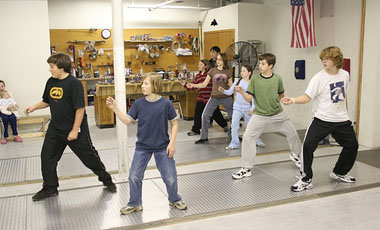 We’ve all seen it happen; heck we all do it. After a long day of grinding out projects or tasks at work, we often end up sitting in front of the “boob tube” or hopping on the computer to surf the net or play a few minutes (right) of World of Warcraft or some other game.
We’ve all seen it happen; heck we all do it. After a long day of grinding out projects or tasks at work, we often end up sitting in front of the “boob tube” or hopping on the computer to surf the net or play a few minutes (right) of World of Warcraft or some other game.
It is especially easy for children to get caught up in sitting in front of the TV or playing computer or console games. It may seem like a struggle to tear your child away from the technology that is so available and ready for them. If you want to make sure your child is receiving a well-rounded childhood and setting the pattern for future good health habits, then getting them to play sports is something you should do.
The best thing you can do is to show your children that being active, either outdoors or indoors, is fun and beneficial. Getting involved in fencing will not only help develop their bodies and minds, it will help them to recognize the importance of staying in shape when they are older. More and more children are growing up overweight or obese, even from the age of five.
Fencing is an activity that all ages can participate in. You can learn alongside your child and get a good workout too. The physical activity is complemented by the mental play in fencing as you have to solve the problems presented by your opponent to score points. This gets your children learning action/reaction as well as basic strategy without ever working to teach them. Most fencing clubs also have equipment to use for free, and then when your children become hooked, you can buy your own set of fencing gear or try an area vendor for a fencing starter kit.
All in all, the focus should be on getting your children up and moving at least 30 minutes a day. By having something where the child is being encouraged to move around and is doing it with their peers, it will be easier to build a foundation for good physical health through activity. Fencing is one such sport, as it involves individual play, problem solving, as well as cooperation as children learn together in the fencing classes.
Did I mention that it’s swordfighting—and that is just plain cool!
Written by Craig Harkins
fencing.net